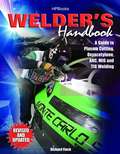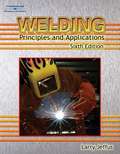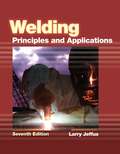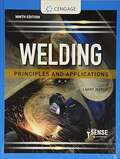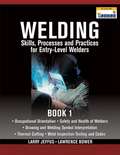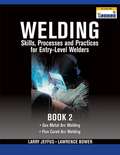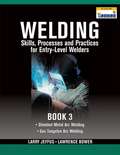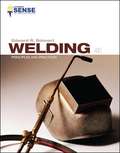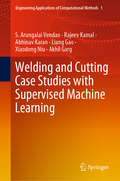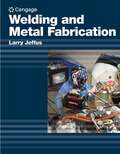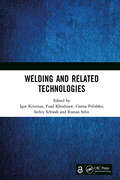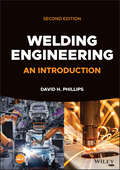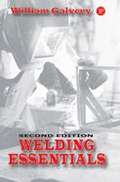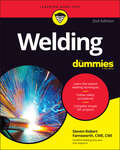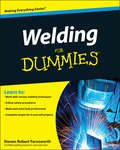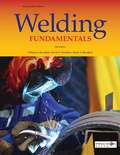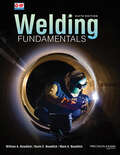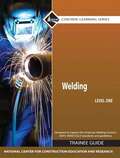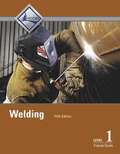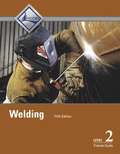- Table View
- List View
Welder's Handbook: A Guide to Plasma Cutting, Oxyacetylene, Arc, MIG and TIG Welding
by Richard FinchThe author talks about the evolution of welding along with technology, mentioning how arc welding equipment which once used to be the size of a refrigerator is now available as a compact pluggable gadget.
Welding (Fundamentals of Service Series)
by Deere Company StaffThe main purpose of this manual is to explain the different types of welding processes, cutting, brazing, soldering, surfacing, design of welds, properties of metals and welding safety. For the novice, this manual is a training guide. All-new welding projects at the end of the book augment this training. For the journeyman, it is a reference. This manual can be used by anyone -- experienced mechanics and shop trainees; as well a vocational students and interested laymen. It starts with the basics and builds your knowledge step-by-step in a very structured manner, making the information easy to understand.
Welding: Principles and Applications
by Larry JeffusThis newly updated sixth edition of Welding: Principles and Applications features tight shots of actual welds to speed beginners to an understanding of a variety of different welding processes used today. Moving quickly from basic concepts to the study of today's most complex welding technologies, each section begins by introducing readers to the materials, equipment, setup procedures, and critical safety information they need to know to successfully execute a specific process. Remaining chapters in the section zero in on individual welding tasks and must-know techniques. Comprehensive coverage spans from specific welding processes to discussion of related topics, including welding metallurgy, metal fabrication, weld testing and inspection, joint design, and job costing. Objectives, key terms, review questions, lab experiments, and practice exercises in every chapter are also included to focus attention on information and skills required for success as a professional welder.
Welding: Principles and Applications
by Larry Jeffus<p>This proven guide provides students with the knowledge and skills they need to complete AWS SENSE Level I and Level II programs, create Workmanship Qualification Specimens, and earn professional certification. Advancing rapidly from basic concepts and processes to today’s most complex, cutting-edge welding technologies and practices, this comprehensive text features valuable information on topics such as welding metallurgy, metal fabrication, weld testing and inspection, joint design, job costing, and environmental and conservation tips. <p>The author opens each section by introducing students to the materials, equipment, setup procedures, and critical safety information they need to execute a specific process successfully, while subsequent chapters focus on individual welding tasks leading to SENSE certification.</p>
Welding: Principles and Applications
by Larry JeffusNow nearing its 30th year of publication, WELDING: PRINCIPLES & APPLICATIONS (WP&A), 7th Edition is the authoritative introduction to the subject of welding. It's designed for students in a wide range of academic and workforce training programs who want to pursue careers as skilled welders and welding supervisors. The text also supports the needs of learners who need to achieve a basic level of proficiency in welding in their chosen skilled trade. While covering the procedural and safety information all students need, WELDING: PRINCIPLES & APPLICATIONS also explains underlying theories. The combination of hands-on information with clear explanations of theory is a hallmark of this book. The depth of coverage allows it to be used as the core text in a multi-course welding curriculum, generally starting with shielded metal arc welding, and then covering other basic processes and more advanced techniques.
Welding: Principles and Applications
by Larry JeffusThis proven guide provides the knowledge and skills you need to complete AWS SENSE Level I and Level II programs, create Workmanship Qualification Specimens, and earn professional certification. Advancing rapidly from basic concepts and processes to today s most complex, cutting-edge welding technologies and practices, this comprehensive text features valuable information on topics such as welding metallurgy, metal fabrication, weld testing and inspection, joint design, job costing, and environmental and conservation tips. <p><p>The author opens each section by introducing you to the materials, equipment, setup procedures, and critical safety information you need to execute a specific process successfully, while subsequent chapters focus on individual welding tasks leading to SENSE certification. <p><p>In addition to hundreds of new photos showcasing current welding tools and techniques, the Ninth Edition includes new and updated information on GTAW cup walking, induction welding machine operations, innovations in PAC equipment, and other industry advances you are likely to encounter as you begin your career as a welding professional.
Welding: Principles and Applications (6th edition)
by Larry JeffusThis newly updated sixth edition of Welding: Principles and Applications features tight shots of actual welds to speed beginners to an understanding of a variety of different welding processes used today. Moving quickly from basic concepts to the study of today's most complex welding technologies, each section begins by introducing readers to the materials, equipment, setup procedures, and critical safety information they need to know to successfully execute a specific process. Remaining chapters in the section zero in on individual welding tasks and must-know techniques. Comprehensive coverage spans from specific welding processes to discussion of related topics, including welding metallurgy, metal fabrication, weld testing and inspection, joint design, and job costing. Objectives, key terms, review questions, lab experiments, and practice exercises in every chapter are also included to focus attention on information and skills required for success as a professional welder.
Welding: Book One
by Larry Jeffus Lawrence BowerWelding: Skills, Processes, and Practices for Entry-Level Welders is an exciting new series that has been designed specifically to support the American Welding Society’s (AWS) SENSE EG2. 0 training guidelines. Offered in three volumes, these books are carefully crafted learning tools consisting of theory-based texts that are accompanied by companion lab manuals, and extensive instructor support materials. With a logical organization that closely follows the modular structure of the AWS guidelines, the series will guide readers through the process of acquiring and practicing welding knowledge and skills. For schools already in the SENSE program, or for those planning to join, Welding: Skills, Processes, and Practices for Entry-Level Welders offers a turnkey solution of high quality teaching and learning aids.
Welding: Book 2
by Larry Jeffus Lawrence BowerWelding: Skills, Processes, and Practices for Entry-Level Welders is an exciting new series that has been designed specifically to support the American Welding Society’s (AWS) SENSE EG2. 0 training guidelines. Offered in three volumes, these books are carefully crafted learning tools consisting of theory-based texts that are accompanied by companion lab manuals, and extensive instructor support materials. With a logical organization that closely follows the modular structure of the AWS guidelines, the series will guide readers through the process of acquiring and practicing welding knowledge and skills. For schools already in the SENSE program, or for those planning to join, Welding: Skills, Processes, and Practices for Entry-Level Welders offers a turnkey solution of high quality teaching and learning aids.
Welding: Book 3
by Larry Jeffus Lawrence BowerWelding: Skills, Processes, and Practices for Entry-Level Welders is an exciting new series that has been designed specifically to support the American Welding Society’s (AWS) SENSE EG2. 0 training guidelines. Offered in three volumes, these books are carefully crafted learning tools consisting of theory-based texts that are accompanied by companion lab manuals, and extensive instructor support materials. With a logical organization that closely follows the modular structure of the AWS guidelines, the series will guide readers through the process of acquiring and practicing welding knowledge and skills. For schools already in the SENSE program, or for those planning to join, Welding: Skills, Processes, and Practices for Entry-Level Welders offers a turnkey solution of high quality teaching and learning aids.
Welding: Principles and Practices
by Raymond J. Sacks Edward R. BohnartThis text introduces students to a solid background in the basic principles and practices of welding. It first introduces fundamental theory of the welding process (gas arc, semi-automatic, automatic, and robotic welding) and then provides practice jobs so students develop manipulative skills and technical understanding. Metals and their welding characteristics, safety practices, welding symbols, and the fundamentals of print reading are all covered.
Welding and Cutting Case Studies with Supervised Machine Learning (Engineering Applications of Computational Methods #1)
by S. Arungalai Vendan Rajeev Kamal Abhinav Karan Liang Gao Xiaodong Niu Akhil GargThis book presents machine learning as a set of pre-requisites, co-requisites, and post-requisites, focusing on mathematical concepts and engineering applications in advanced welding and cutting processes. It describes a number of advanced welding and cutting processes and then assesses the parametrical interdependencies of two entities, namely the data analysis and data visualization techniques, which form the core of machine learning. Subsequently, it discusses supervised learning, highlighting Python libraries such as NumPy, Pandas and Scikit Learn programming. It also includes case studies that employ machine learning for manufacturing processes in the engineering domain. The book not only provides beginners with an introduction to machine learning for applied sciences, enabling them to address global competitiveness and work on real-time technical challenges, it is also a valuable resource for scholars with domain knowledge.
Welding and Metal Fabrication
by Larry JeffusWELDING AND METAL FABRICATION employs a unique hands-on, project-based learning strategy to teach welding skills effectively and keep you motivated. This groundbreaking new book connects each welding technique to a useful and creative take-home project, making exercises both practical and personal―and avoiding the tedium of traditional, repetitive welding practices. To further enhance the learning process, every welding project includes a set of prints with specifications, like those used in production fabrication shops. This full-featured approach to skill-building reflects the reality of professional welding, where following prints and instructions precisely and laying out, cutting out, and assembling weldment accurately are just as essential as high-quality welding. The included projects are small to conserve materials during the learning process, but detailed instructions and abundant photos and illustrations guide you through a wide range of fabrication skills. Key steps and techniques within the small projects are also linked to larger projects presented at the end of each chapter, enabling you to apply what you have learned by fabricating and welding something more substantial. This thorough, reader-friendly book also prepares you for real-world success by covering shop math and measurement, time and material tracking, and invoicing.
Welding and Related Technologies: Proceedings of the VIIth International Conference on Welding and Related Technologies (WRT 2024, 7-10 October 2024, Yaremche, Ukraine)
by Igor KrivtsunWelding and Related Technologies contains the papers presented at the VIIth International Conference on “Welding and Related Technologies” (WRT 2024, Yaremche, Ukraine, 7-10 October 2024). The topics covered include: Innovative Technologies, Materials and Equipment for Welding and Related Processes Strength and Stress-Strain States of Welded Joints and Structures Additive Technologies New Structural And Functional Materials, Nanomaterials, Composites Surface Engineering Mathematical Modeling of Welding And Related Processes Advanced Technologies of Special Electrometallurgy Non-Destructive Testing and Technical Diagnostics Materials and Technologies for Medicine and Ecology of Welding Production Welding and Related Technologies is of interest to scientists from academic institutions, universities and industry, domain experts, and postdoctoral fellows interested in the latest theoretical developments and applications of welding.
Welding Engineering
by David H. PhillipsProvides an introduction to all of the important topics in welding engineering. It covers a broad range of subjects and presents each topic in a relatively simple, easy to understand manner, with emphasis on the fundamental engineering principles.* Comprehensive coverage of all welding engineering topics * Presented in a simple, easy to understand format * Emphasises concepts and fundamental principles
Welding Engineering: An Introduction
by David H. PhillipsWELDING ENGINEERING The new edition of the popular welding engineering textbook includes brand-new topics, assignments, and review questions Welding Engineering: An Introduction provides a clear and accessible overview of the concepts, tools, materials, and methods of modern welding and joining technology. With emphasis on fundamental engineering principles, this comprehensive textbook offers easy-to-understand coverage of a wide range of key topics in welding engineering, from the basics of arc welding processes to welding metallurgy, design, and safety. Concise chapters offer numerous figures, tables, images, and recommended readings to promote reader comprehension of the material. Now in its second edition, the text contains fully revised content throughout, including entirely new sections on additive manufacturing and computational modeling of welds. Updated and expanded chapters address modern arc welding power supply technology, resistance, solid-state, and high energy density welding processes, weld inspection methods, codes and standards, welding of high strength steels, and more. This edition features simple yet effective end-of-chapter assignments that enhance students’ learning and assist instructors in developing assessment questions for their course. The second edition of Welding Engineering: Provides up-to-date coverage of rapidly growing techniques and technologies within the field Features new assignments and true/false questions at the end of each chapter Explains the essential concepts and principles necessary for more in-depth courses in welding, metallurgy, and design Covers all the major welding processes used in manufacturing and fabrication Welding Engineering: An Introduction, Second Edition is an excellent textbook for undergraduate and graduate welding engineering courses taught within four-year engineering degree programs, and a valuable guide for engineers and professionals in the manufacturing industry who need to learn fundamental welding engineering concepts for their job roles.
Welding Essentials: Questions and Answers
by William L. Glavey Frank M. Marlow Pamela Tallman Lawrence SmithExpanded to include a new and heavily illustrated chapter on fabrication and repair tips. Presents all essential material for beginning welders in small, easy-to-read and understand units. Introduces the beginning welder to weld inspection, welding symbols and qualification and certification issues. Can be used in conjunction with welding processes and safety seminars, and as a result become a tremendous asset to companies needing to log and claim that they put printed safety materials into employees' hands. Discusses the difference between constant voltage and constant current power supplies and traces the development of welding power supplies from motor-generator sets to transformers to the inverters of today. A metallurgy chapter explains how welding heat affects metals' properties and how to minimize its negative effects and provides a clear explanation of hardening, tempering and heat treating steel. More than 300 illustrations clarify and detail explanations of every subject. Includes a comprehensive glossary in English and Spanish.
Welding For Dummies
by Steven Robert FarnsworthEvery critical welding technique and process distilled into a one-stop, accessible resource Safe and effective welding might seem like a pipe dream if you’re just getting started. But with a little help from Welding For Dummies you’ll be a “golden arm” in no time. This guide will give you techniques you need to get a handle on material evaluation, clean-up, and every step in between. You’ll find practical advice on every popular kind of welding, including stick, tig, mig, fluxcore, and even oxyfuel cutting. You’ll also get tips on the ideal welding techniques to choose for specific projects. The book shows you how to: Find the required training for welding certifications Use brand-new welding technologies, including laser techniques Practice critical welding techniques you can use in your own hobby shop while staying safe Whether you’re looking for some help to further your do-it-yourself projects at home or you’re just getting started with a traditional welding educational program and you need a useful supplementary resource, Welding For Dummies is an irreplaceable reference that helps make a challenging trade accessible to everyone.
Welding For Dummies
by Steven Robert FarnsworthGet the know-how to weld like a pro Being a skilled welder is a hot commodity in today's job market, as well as a handy talent for industrious do-it-yourself repairpersons and hobbyists. Welding For Dummies gives you all the information you need to perform this commonly used, yet complex, task. This friendly, practical guide takes you from evaluating the material to be welded all the way through the step-by-step welding process, and everything in between. Plus, you'll get easy-to-follow guidance on how to apply finishing techniques and advice on how to adhere to safety procedures. Explains each type of welding, including stick, tig, mig, and fluxcore welding, as well as oxyfuel cutting, which receives sparse coverage in other books on welding Tips on the best welding technique to choose for a specific project Required training and certification information Whether you have no prior experience in welding or are looking for a thorough reference to supplement traditional welding instruction, the easy-to-understand information in Welding For Dummies is the ultimate resource for mastering this intricate skill.
Welding Fundamentals
by William A. Bowditch Kevin E. Bowditch Mark A. BowditchWelding Fundamentals is designed to provide students with a strong understanding of the underlying theory and skills required for successful welding, with a strong emphasis on safety. It provides all of the information needed to help students develop proficiency with the most common welding processes (including GTAW, GMAW, FCAW, SMAW, and oxyfuel welding), thermal cutting, basic print reading and weld symbology, and joint design and fit up. The text also introduces students to weld inspection and testing. Covers all of the key indicators for AWS SENSE Level-1 certification, so the book can be used in all courses leading to SENSE Level-1 certification. This book is designed so that sections of the book can be taught in any order, making the book easily adaptable to any course.
Welding Fundamentals
by William A. Bowditch Kevin E. Bowditch Mark A. BowditchWelding Fundamentals provides students with a strong understanding of the underlying theory and skills required for successful welding, with a strong emphasis on safety. It provides all of the information needed to help students develop proficiency with the most common welding processes (including SMAW, GMAW, FCAW, GTAW, and oxyfuel welding), thermal cutting, welding symbols and basic print reading, and joint design and fit up. The text also introduces students to weld inspection and testing. The book covers all of the key indicators for AWS SENSE Level-1 certification, so it can be used in all courses leading to SENSE Level-1 certification. It includes chapters on basic math and math applications in welding. The sections of the book can be taught in any order, making it easily adaptable to any course.
Welding Handbook Volume 3
by American Welding SocietyThis authoritative resource brings together 600 pages of comprehensive information on solid-state and other welding and cutting processes. The book includes chapters on the following welding processes: resistance spot and seam, projection, flash and upset, and high-frequency. The final chapter covers various other welding and cutting processes, including modernized water jet cutting. Written, updated, and peer reviewed by a group of highly respected technical and scientific experts.•Provides a comprehensive chapter on resistance welding equipment, with photos of state-of-the-art equipment and accompanied by new electrical diagrams and drawings.• In addition to a chapter on friction welding, a new chapter introduces friction stir welding, the process that has users excited about its significant advantages.• Discusses the most recent developments in beam technology in greatly expanded chapters on laser beam welding and cutting and electron beam welding.• Presents a diverse array of processes in chapters on ultrasonic welding, explosion welding, diffusion welding and diffusion brazing, adhesive bonding, and thermal and cold spraying.• Also discusses various other welding and cutting processes, including sections on two emerging processes: magnetic pulse welding and electro-spark deposition, plus the return of water jet cutting as a modern process.• Includes a section on safe practices specific to the process in each chapter. This volume is devoted to information on resistance welding, solid state processes, and other joining and cutting methods. It contains updated resistance welding chapters: spot and seam welding, projection welding, flash and upset welding, high-frequency welding, and resistance welding equipment. The chapter on friction welding been updated. New in this edition is a separate chapter on the developing process variation of friction stir welding. Other chapters explore ultrasonic welding, explosion welding, adhesive bonding, thermal spraying and cold spraying, diffusion welding, and diffusion brazing. The chapters on electron beam welding and laser beam welding and cutting contain significantly expanded technology. The last chapter, Other Welding and Cutting Processes, contains information on two new or revitalized processes, magnetic pulse welding, and electro-spark depositing. New information is presented on water jet cutting, which is reappearing in many current applications as a modern, efficient process.
Welding Level 1 Trainee Guide
by NccerThis exceptionally produced trainee guide features a highly illustrated design, technical hints and tips from industry experts, review questions and a whole lot more! Key content includes Welding Safety, Oxyfuel Cutting, Plasma Arc Cutting, Air Carbon Arc Cutting and Gouging, Base Metal Preparation, Weld Quality, SMAW ― Equipment and Safety, Shielded Metal Arc Electrodes, SMAW ― Beads and Fillet Welds, Joint Fit-Up and Alignment, SMAW ― Groove Welds and Backing, and SMAW ― Open V-Groove Welds.
Welding Level 1 Trainee Guide (5th Edition)
by Nccer<p>Few career choices offer as many options for employment and opportunities for growth. According to the Department of Labor, "the basic skills of welding are similar across industries, so welders can easily shift from one industry to another, depending on where they are needed most." Welders will continue to be in high demand since there is a continual need to rebuild aging infrastructure such as highways and buildings. In addition, the creation of new power generation facilities will yield new job prospects for trained and skilled welders. Evolving technology creates more uses for welding in the workplace. For example, new methods are being developed to bond dissimilar materials and nonmetallic materials such as plastics, composites, and new alloys. Also, advances in laser beam and electron beam welding, new fluxes, and other new technologies and techniques all point to an increasing need for educated, skilled welders. <p>This fifth edition of Welding Level One introduces the fundamentals of the welding trade. The four levels of this curriculum present an apprentice approach and will help you be knowledgeable, safe, and effective on the job. The Welding curriculum has been revised by industry subject matter experts from across the nation who have incorporated the latest methods and technology of the trade.</p>
Welding Level 2 Trainee Guide (Fifth Edition)
by NccerThe 5th edition of this trainee guide features illustrated design, technical hints and tips from industry experts, review questions and a whole lot more! Key content includes Welding Symbols, Reading Welding Detail Drawings, Physical Characteristics and Mechanical Properties of Metals, Preheating and Postheating of Metals, GMAW & FCAW - Equipment and Filler Metals, GMAW & FCAW - Plate, GTAW - Equipment and Filler Metal, and GTAW - Plate.
